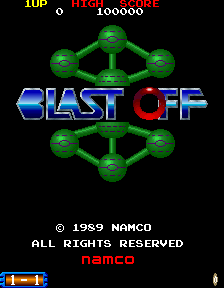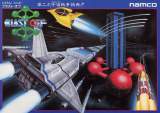

Blast Off © 1989 Namco.
A vertically scrolling shoot'em up. Despite the drastically different gameplay, Blast Off is the sequel to Bosconian which was released eight years earlier.
As in many other vertical scrolling shooters (including Namco's own Xevious), the player controls a ship, facing the top of the screen, that can move freely while the background scrolls down, bringing enemies in to view; the player may destroy enemies for points. The game uses two buttons - one is used to make the ship fire circular lasers, while the other is used to cycle through its four firing patterns. The red pattern is two lasers in a spiral pattern, while the blue one is one laser straight ahead and one behind, the yellow one is one laser straight ahead, one left, and one right and the green one is two lasers diagonally forward (one to the left and one to the right), and one straight behind; by holding down the button, the ship fires more powerful, spherical lasers.

Namco System 1 hardware
Game ID : BO
Main CPU : 6809 (@ 1.536 Mhz)
Sub CPU : 6809 (@ 1.536 Mhz)
Sound CPU : 6809 (@ 1.536 Mhz)
MCU : HD63701 (@ 1.536 Mhz)
Sound Chips : Yamaha YM2151 (@ 3.57958 Mhz), Namco advanced 8-channel stereo WSG, stereo DAC
Players : 2
Control : 8-way joystick
Buttons : 2
Blast Off was released in March 1989 in Japan.
Even though the game is the sequel to Bosconian (which used a synthesized, DAC-generated voice saying "Blast off!" at the beginning of every round), Blast Off had more in common gameplay-wise with Namco's own Dragon Spirit than with Bosconian; this is especially noticeable in the third area of every world, where the player's ship undergoes an increase in size, and must destroy a boss. Despite several gameplay differences, the connection with Bosconian was emphasized in the marketing of the game, with the hexagonal space stations from Bosconian appearing in Namco's press literature, the game's title screen, and in the game itself.
The game is also worth noting for its usages of various "Engrish" phrases, such as "To push start only 1 player button" (on title screen), "Go next" (at end of world), "Congraturations" (at end of game) and "Entry your name" (on high score table). There are a total of six worlds in this game, and each one has three areas (so there are a total of eighteen "stages" to play through).
Victor Entertainment released a limited-edition soundtrack album for this game (Namco Videogame Graffiti Vol.10 - VICL-40097) on 16/12/1993.
Game's ROM.
Game's screenshots.